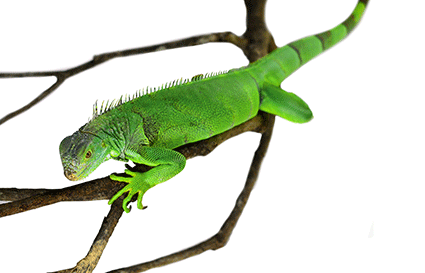
Iguanas are one of the most interesting breed of large lizards that are
becoming more and more popular to own as a pet. These lizards can grow up to 6
feet long and weigh as much as 20 pounds, although it’s really the tail that
makes the iguana appear so long. When you first bring your lizard home, there
isn’t much to expect in terms of activity. Playing with the iguana too soon can
cause your new pal to become very stressed out and it will make the task of
taming very difficult.
Did you know?
Igunanas have a third eye called a “parietal eye” located on top of their head.
This eye functions differently from their other two eyes because it helps these
lizards detect movement from above to avoid flying predators.
Iguanas are excellent swimmers and will dive into water if threatened.
The tails of these lizards can break off if grabbed, but it’s okay because the
tail will grow back.
A checklist of what you’ll need to care for your lizard properly:
- Caging
- Substrate
- Lighting and Temperature
- Water
- Food
Caging
For a baby or young lizard, a 20 gallon aquarium is perfect. Putting your pet in
an enclosure that is too large can make it difficult for them to find food and
water. However, when your iguana begins to grow, you will need to expand their
housing to something much MUCH larger than a 20 gallon aquarium tank. Adult
lizards need an enclosure roughly 12 feet long, 6 feet wide, and 6 feet high.
Remember, these lizards can grow up to 6 feet in length, so they need a large
area to roam.
Substrate
Substrate is what you line the cage with. For adults, rabbit or alfalfa pellets
work appropriately because even if they’re accidentally consumed, no harm will
come to the lizard. For an inside enclosure, consider using cypress mulch.
Lighting and Temperature
These lizards need a lot of heat. For your new baby, one heat lamp will work
perfectly but as your pet grows in size, you will need at least 6 lights by the
time adulthood is reached. You will want to create a hotspot of 120 degrees
Fahrenheit where the heat comes from above the lizard to allow the parietal eye
to engage and therefore allowing your pal to naturally thermoregulate. Other
parts of the cage should be kept cooler, allowing your lizard to care for it’s
needs depending on the desire to be warmer or cooler. Keep the warm end at 120
degrees Fahrenheit and the cooler end around 80 degrees Fahrenheit. Do NOT use
heat rocks, heating pads, or any heating element that radiates from the bottom!
Your lizard could burn itself on these items!
Water
When you first come home with your new lizard, remember that sometimes babies
have a difficult time finding their water. Make sure you always have water
available but until you are positive that your lizard can always locate the
water source, be sure to mist them daily and soak them in water at least twice a
week. This ensures they’re properly hydrated. Your best bet is to provide a
water dish that is big enough for your lizard to get in and soak. These lizards
live near the water when in the wild and are excellent swimmers. It can be sort
of a play time as well as relaxation!
Food
First and foremost, you should know that these lizards cannot chew their food,
instead they swallow each bit whole. There is no need to purchase specialty food
for your scaly pal, but if you wish to do so you can find specialty foods at any
store that caters to lizards. If you’re looking for a more natural diet, foods
such as collard greens, turnip greens, dandelions, yellow squash, and green
beans are excellent diet choices. Providing fruit once a week is okay too, but
keep in mind that too much fruit can cause diarrhea. (EW!) For a baby, cut foods
up in small enough sizes that it can be swallowed easily. Add a calcium
supplement to the food once a week but stay FAR away from a diet rich in
protein. This will eventually lead to renal failure of your lizard.
Remember each bullet point in this checklist when purchasing your lizard and the
care taking process will go very smoothly and you’ll have a happy friend for
many years. While it might be tempting to show off your pal as soon as you get
home, remember these lizards need time to acclimate to their surroundings but
don’t worry, over time you will see your lizard as a companion. It might even
start to recognize you and you’ll be surprised at the affection and intelligence
shown. Best of luck to you and enjoy your new friend!

